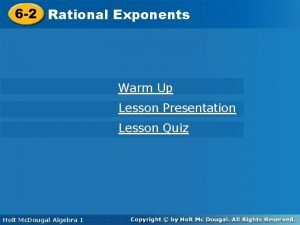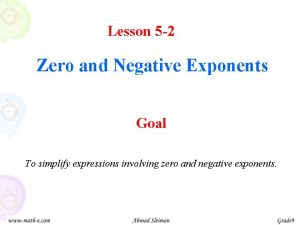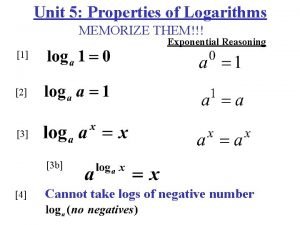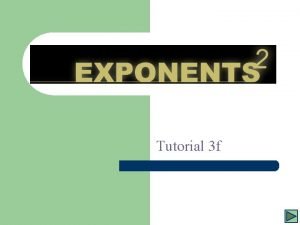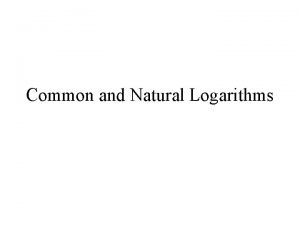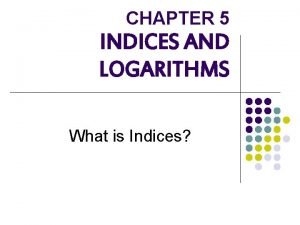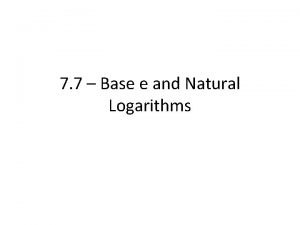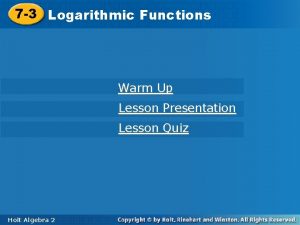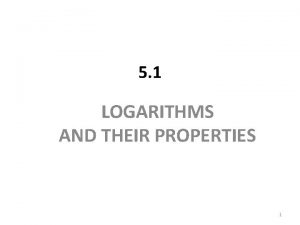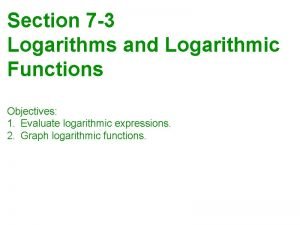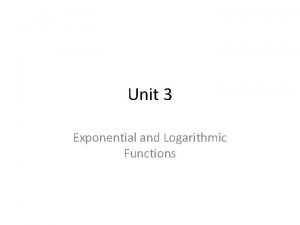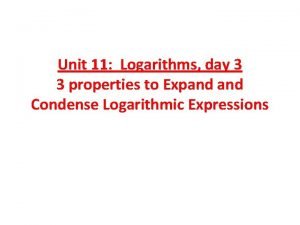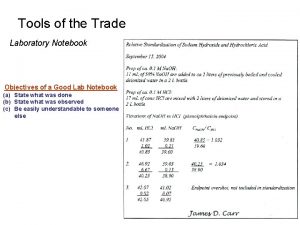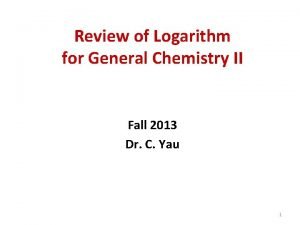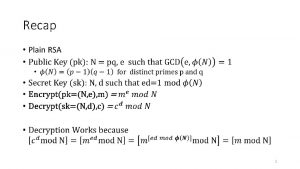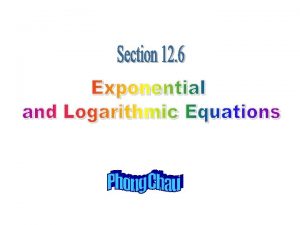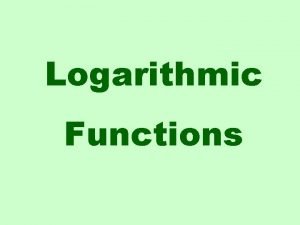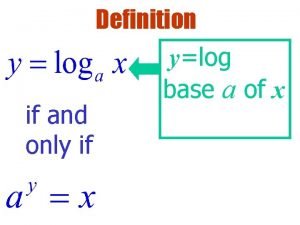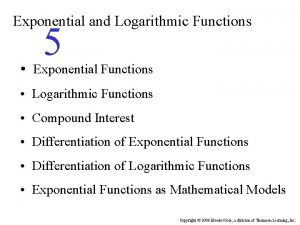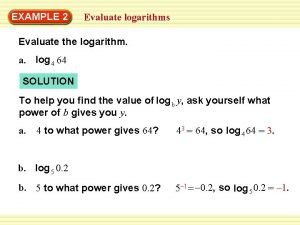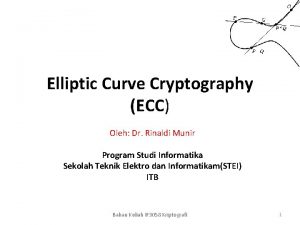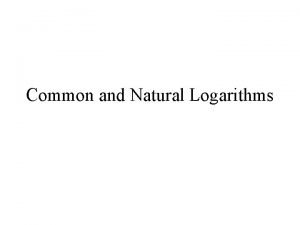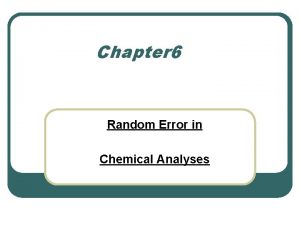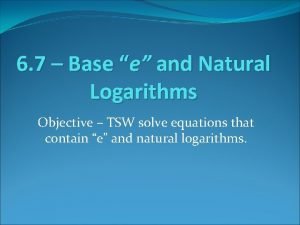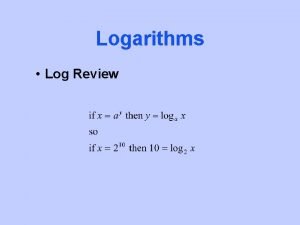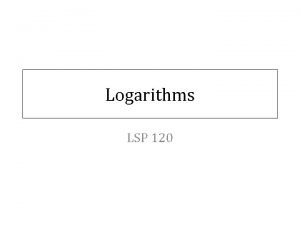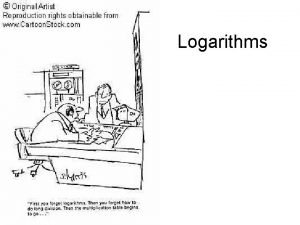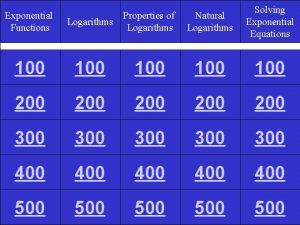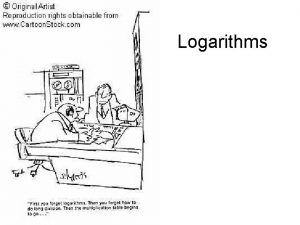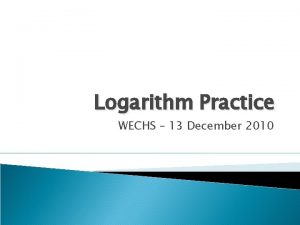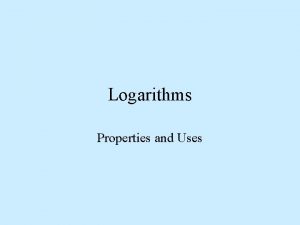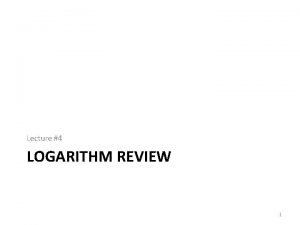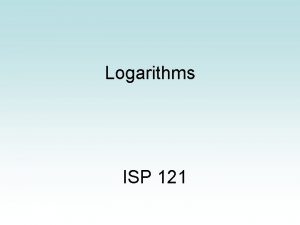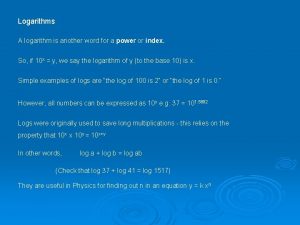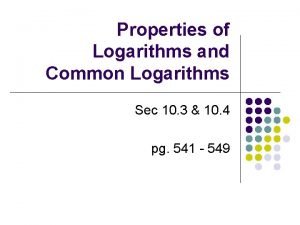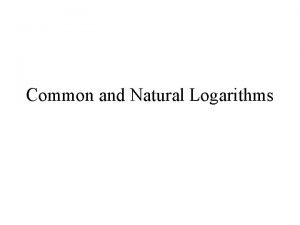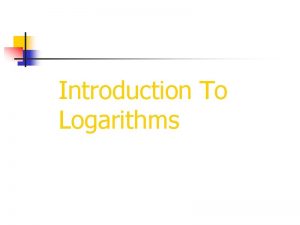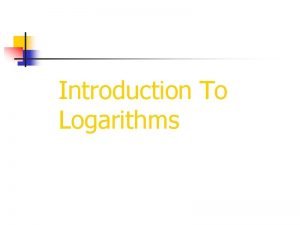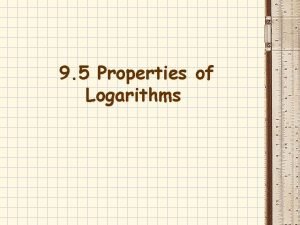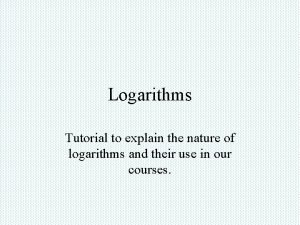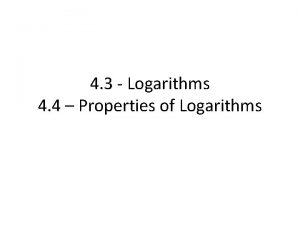Exponents and Logarithms Definition of a Logarithm Rules



























- Slides: 27

Exponents and Logarithms ª Definition of a Logarithm ª Rules ª Functions ª Graphs ª Solving Equations ©Carolyn C. Wheater, 2000 1

Definition of a Logarithm ª A logarithm, or log, is defined in terms of an exponential. ª If bx=a, then logba=x © If 52=25 then log 525=2 © log 525=2 is read “the log base 5 of 25 is 2. ” © You might say the log is the exponent we put on 5 to make 25 ©Carolyn C. Wheater, 2000 2

Rules for Exponents ª Exponents give us many shortcuts for multiplying and dividing quickly. ª Each of the key rules for exponents has an important parallel in the world of logarithms. ©Carolyn C. Wheater, 2000 3

Multiplying with Exponents ª To multiply powers of the same base, keep the base and add the exponents. Can’t do anything about the y 3 because it’s not the same base. Keep x, add exponents 7 + 5 ©Carolyn C. Wheater, 2000 4

Dividing with Exponents ª To divide powers of the same base, keep the base and subtract the exponents. Keep 7, subtract 10 -6 Keep 5, subtract 12 -4 ©Carolyn C. Wheater, 2000 5

Powers with Exponents ª To raise a power to a power, keep the base and multiply the exponents. This means t 7·t 7 = t 7+7+7 ©Carolyn C. Wheater, 2000 6

Rules for Logarithms ª Just as the rules for exponents let you easily rewrite a product, quotient, or power, the corresponding rules for logs allow you to rewrite the log of a product, the log of a quotient, or the log of a power. ©Carolyn C. Wheater, 2000 7

Log of a Product ª Logs are exponents in disguise © To multiply powers, add exponents © To find the log of a product, add the logs of the factors ª The log of a product is the sum of the logs of the factors ©logbxy = logbx + logby ©log 5(25· 125) = log 525 + log 5125 ©Carolyn C. Wheater, 2000 8

Log of a Product ª Think about it: © 25· 125 = 52 · 53 = 52+3=55 Laws of Exponents © log 5(25 · 125) = log 5(52 · 53)=log 5(52)+log 5(53) ¨ log 525 = log 5(52)=2 ¨ log 5125 = log 5(53)=3 Logs are Exponents! Add the exponents! © log 5(25 · 125) = log 5(52)+log 5(53) = 2 + 3 = 5 © log 5(25 · 125) = log 5(55) =5 ©Carolyn C. Wheater, 2000 9

Log of a Quotient ª Logs are exponents © To divide powers, subtract exponents © To find the log of a quotient, subtract the logs ª The log of a quotient is the difference of the logs of the factors © logb = logbx - logby © log 5(125 25) = log 5125 - log 525 ©Carolyn C. Wheater, 2000 10

Log of a Quotient ª Think about it: © 125 25 = 53 52 = 53 -2=51 Laws of Exponents © log 5(125 25) = log 5(53 52) = log 5(53) - log 5(52) ¨ log 5125 = log 5(53)=3 ¨ log 525 = log 5(52)=2 Logs are Exponents! Subtract the exponents! © log 5(125 125) = log 5(53)-log 5(52) = 3 - 2 = 1 © log 5(125 25) = log 5(51) =1 ©Carolyn C. Wheater, 2000 11

Log of a Power ª Logs are exponents © To raise a power to a power, multiply exponents © To find the log of a power, multiply the exponent by the log of the base ª The log of a power is the product of the exponent and the log of the base © logbxn = nlogbx © log 32 = 2 log 3 ©Carolyn C. Wheater, 2000 12

Log of a Power ª Think about it: © 252 =( 52)2 = 52 · 2=54 Laws of Exponents © log 5(252) = 2 log 5(52) ¨ log 525 = log 5(52)=2 ©log 5(252) = 2 log 5(52) = 2 · 2 = 4 Logs are Exponents! Multiply the exponent by the log (an exponent!) © log 5(252) = log 5(625) = log 5(54) = 4 ©Carolyn C. Wheater, 2000 13

Rules for Logarithms ª The same rules can be used to turn an expression into a single log. © logbx + logby = logbxy © logbx - logby = logb © nlogbx = logbxn ©Carolyn C. Wheater, 2000 14

Rules for Logarithms ª A sum of two logs becomes the log of a product. © log 39 + log 327 = log 3(9· 27) ª A difference of two logs becomes the log of a quotient. © log 232 - log 28 = log 2 Bases must be the same ª A multiple of a log becomes the log of a power © 2 log 57 = log 572 ©Carolyn C. Wheater, 2000 15

Sample Problem ª Express as a single logarithm: 3 log 7 x + log 7(x+1) - 2 log 7(x+2) © 3 log 7 x = log 7 x 3 © 2 log 7(x+2) = log 7(x+2)2 log 7 x 3 + log 7(x+1) - log 7(x+2)2 © log 7 x 3 + log 7(x+1) = log 7(x 3·(x+1)) - log 7(x+2)2 © log 7(x 3·(x+1)) - log 7(x+2)2 = ©Carolyn C. Wheater, 2000 16

Exponential Functions ª The exponential function has the form f(x)=abx © a is the beginning, or initial amount © b is the base, the factor that represents the rate of increase © x is the exponent, often representing a period of time ©Carolyn C. Wheater, 2000 17

Logarithmic Functions ª The logarithmic function has the form f(x)=logbx © b is the base © x is the number © f(x) is the log (or disguised exponent) ©Carolyn C. Wheater, 2000 18

Graphs of Exponential Functions ª The graph of f(x)=bx has a characteristic shape. © If b>1, the graph rises quickly. © If 0 < b < 1, the graph falls quickly. © Unless translated the graph has a y-intercept of 1. ©Carolyn C. Wheater, 2000 24 19

Graphs of Logarithmic Functions ª The graph of f(x)=logbx has a characteristic shape. © The domain of the function is {x| x>0} -1 © Unless translated, the graph has an x-intercept of 1. 1 ©Carolyn C. Wheater, 2000 2 3 4 5 6 20

Translating the Graphs ª Both exponential and logarithmic functions can be translated. ª The vertical and horizontal slides will show up in predictable places in the equation, just as for parabolas and other functions. Shifted 1 unit right and 3 down ©Carolyn C. Wheater, 2000 Shifted 6 units left and 4 up 21

Solving Exponential Equations ª If possible, express both sides as powers of the same base ª Equate the exponents ª Solve ©Carolyn C. Wheater, 2000 22

Solving Exponential Equations ª If it is not possible to express both sides as powers of the same base © take the log of each side using any convenient base © use rules for logs to break down the expressions © isolate the variable © evaluate and check ©Carolyn C. Wheater, 2000 23

Solving Exponential Equations ª Solve © Take the log of each side © Use rules for logs ©Isolate the variable © Evaluate and check Any convenient base can be used, and since you’ll want to use your calculator, that will probably be 10 ©Carolyn C. Wheater, 2000 x 0. 675 24

Solving Logarithmic Equations ª Use the rules for logs to simplify each side of the equation until it is a single log or a constant. ©Carolyn C. Wheater, 2000 25

Solving Logarithmic Equations ª Log = Log ©Exponentiate (drop logs) © Solve the resulting equation © Reject solutions that would mean taking the log of a negative number ©Carolyn C. Wheater, 2000 26

Solving Logarithmic Equations ª Log = Constant ©Use the definition of a logarithm to express as an exponential ©Evaluate and check ©Carolyn C. Wheater, 2000 27
 Fraction exponents
Fraction exponents Exponents in fractions
Exponents in fractions Log rules maths
Log rules maths Multiplying exponents
Multiplying exponents Exponent rules subtraction
Exponent rules subtraction Natural and common logarithm
Natural and common logarithm Log and exponential derivatives
Log and exponential derivatives Laws of indices and logarithms
Laws of indices and logarithms 7-7 base e and natural logarithms
7-7 base e and natural logarithms Log form to exponential form
Log form to exponential form Log properties
Log properties 7-3 logarithms and logarithmic functions
7-3 logarithms and logarithmic functions How to write logarithmic form
How to write logarithmic form Quotient property of logarithms examples
Quotient property of logarithms examples Logarithm significant figures
Logarithm significant figures Sig fig rules
Sig fig rules Discrete logarithm
Discrete logarithm Solve simple equations
Solve simple equations Nernst equation simplified
Nernst equation simplified Natural logarithm
Natural logarithm Where is the base of a logarithm
Where is the base of a logarithm Exponential properties
Exponential properties Evaluate meaning in maths
Evaluate meaning in maths Elliptic curve discrete logarithm problem
Elliptic curve discrete logarithm problem Common logarithm examples
Common logarithm examples Logarithm significant figures
Logarithm significant figures Logarithm arithmetic
Logarithm arithmetic 6-8 practice natural logarithms
6-8 practice natural logarithms
